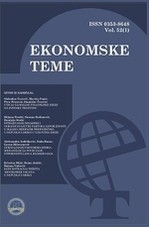Economic Themes (2024) 62 (3) 7, 389-412
Jovana Milenović, Ljiljana Bonić, Bojan Krstić
Abstract: Intellectual capital (IC) contributes to the creation of benefits for companies regarding the generation competitive advantages, as well as the increase of the economic results (revenue and earnings), economic efficiency (labour productivity and profitability) and the value of company. Total IC consists of two main segments: a) the visible IC, recognised and disclosed on the assets side of balance sheet - intangible assets, and b) the invisible IC, undisclosed on the assets side of balance sheet because it doesn’t fulfil the defined conditions for accounting the recognition and disclosure. As a category in accounting theory, the first segment of total IC is the IC invested in intangible assets. The second segment of total IC is actually the IC itself that is in intellectual capital theory marked as a set of human, structural and relational capital. Starting with the structure of total IC, the aim of this study is the examination of influence of the efficiency of total IC and its elements (visible and invisible) on profitability of companies on the New York Stock Exchange (NYSE). The research is based on the sample of 63 IT companies which are selected according to S&P 500 Information Technology list. The analysis covers the period from 2010 to 2022, and the regression analysis is used for these reasons. Independent variables are following: the efficiency of total IC (EIC),the efficiency of IC which is undisclosed in balanced sheet (E∆IC) and the efficiency in the use of intangible assets (Eia), as well as its elements (the efficiency of goodwill (Eg), the efficiency in use of the intangible assets contained in customer relationships (Ecr), the efficiency in the use of internally generated intangible assets (Eiia), and the efficiency in use of others intangible assets (Eoia). A dependent variable is a profitability of IT companies, which is measured by return on assets (ROA) as a profitability indicator. The research results pointed out that there is a positive, statistically relevant influence of efficiency of EIC and elements of Eia (as independent variables) on a dependent variable – ROA. Conducted research points out the relevance of efficiency of the usage of total IC and all its elements for accomplishing a targeted profitability of IT companies, and, at the same time, confirms the usefulness and validity of the implementation of the EIC methodology (Krstić & Bonić, 2016) in IT companies for the measurement of the efficiency of total IC, as well as its elements.
Keywords: total I; visible IC; invisible or intangible IC; EIC methodology; profitability; IT companies
IMPACT OF INTELLECTUAL CAPITAL EFFICIENCY ON PROFITABILITY: THE CASE OF INFORMATION TECHNOLOGY COMPANIES ON THE NYSE
Jovana Milenović, Ljiljana Bonić, Bojan Krstić
Abstract: Intellectual capital (IC) contributes to the creation of benefits for companies regarding the generation competitive advantages, as well as the increase of the economic results (revenue and earnings), economic efficiency (labour productivity and profitability) and the value of company. Total IC consists of two main segments: a) the visible IC, recognised and disclosed on the assets side of balance sheet - intangible assets, and b) the invisible IC, undisclosed on the assets side of balance sheet because it doesn’t fulfil the defined conditions for accounting the recognition and disclosure. As a category in accounting theory, the first segment of total IC is the IC invested in intangible assets. The second segment of total IC is actually the IC itself that is in intellectual capital theory marked as a set of human, structural and relational capital. Starting with the structure of total IC, the aim of this study is the examination of influence of the efficiency of total IC and its elements (visible and invisible) on profitability of companies on the New York Stock Exchange (NYSE). The research is based on the sample of 63 IT companies which are selected according to S&P 500 Information Technology list. The analysis covers the period from 2010 to 2022, and the regression analysis is used for these reasons. Independent variables are following: the efficiency of total IC (EIC),the efficiency of IC which is undisclosed in balanced sheet (E∆IC) and the efficiency in the use of intangible assets (Eia), as well as its elements (the efficiency of goodwill (Eg), the efficiency in use of the intangible assets contained in customer relationships (Ecr), the efficiency in the use of internally generated intangible assets (Eiia), and the efficiency in use of others intangible assets (Eoia). A dependent variable is a profitability of IT companies, which is measured by return on assets (ROA) as a profitability indicator. The research results pointed out that there is a positive, statistically relevant influence of efficiency of EIC and elements of Eia (as independent variables) on a dependent variable – ROA. Conducted research points out the relevance of efficiency of the usage of total IC and all its elements for accomplishing a targeted profitability of IT companies, and, at the same time, confirms the usefulness and validity of the implementation of the EIC methodology (Krstić & Bonić, 2016) in IT companies for the measurement of the efficiency of total IC, as well as its elements.
Keywords: total I; visible IC; invisible or intangible IC; EIC methodology; profitability; IT companies

